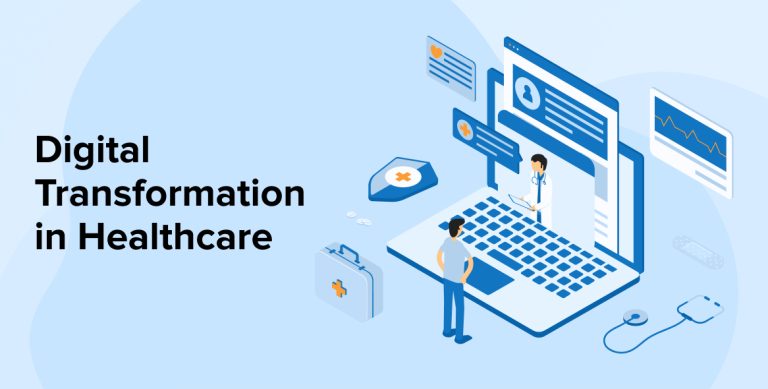
Since the advent of the internet, the world has slowly progressed towards digitalization. This shift was significantly boosted during the COVID-19 pandemic, causing a major revolution across various industries, especially in healthcare.
With the help of a reputed healthcare software development company, healthcare organizations can easily adopt a digital culture of health systems.
A study conducted by Grand View Research has found that digital transformation in healthcare is responsible for enhanced patient interactions and outcomes. In 2023, the US digital health market was estimated at $81.7 billion, which is expected to increase by 19.5% CAGR from 2024 to 2030.
If you want to learn about the benefits and trends in the digital health industry, this article is ideal for you. Additionally, we will explore the challenges that healthcare organizations face when adopting digital technologies.
1. Overview of Digital Transformation in the Healthcare Industry
Digital transformation in the healthcare industry involves leveraging the latest technologies to modernize medical services. The primary goal is to improve operational efficiency to maximize output value for patients and healthcare organizations.
The digitization of healthcare is not about googling your symptoms to find possible diagnoses. It’s about using advanced technologies, including AI and cloud computing, to perform various healthcare activities. These activities include scheduling appointments with a doctor through a mobile app and utilizing robots to conduct remote surgeries.
The purpose of digital transformation in the healthcare sector is to improve the productivity of healthcare professionals, increase the efficiency of medical services, and provide enhanced patient care. It’s a broad field comprising unique integrations of various technologies to provide better healthcare solutions.
2. How Beneficial is Digital Transformation in Healthcare?
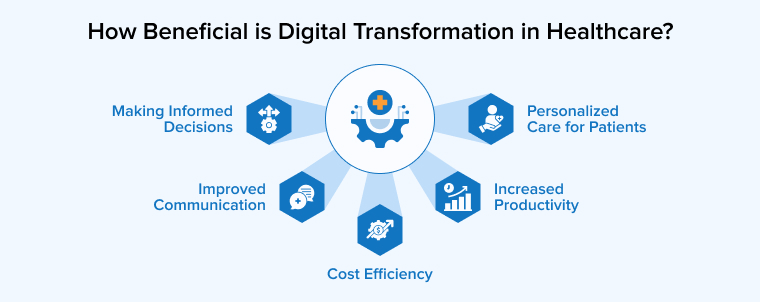
Implementing digital transformation in the healthcare industry means subscribing to many advantages for everyone, including medical staff members, doctors, healthcare researchers, and, of course, patients. Let’s take a brief look at a few top advantages:
2.1 Personalized Care For Patients
In the medical sector, patient care is the top priority. Healthcare software solutions enable the creation of personalized plans tailored to patients’ specific requirements to provide more efficient care. The purpose behind upgrading healthcare services is to enhance the quality of patient care.
Doctors and clinics can utilize electronic health records to store and update patients’ medical histories and profiles. With access to healthcare data, medical professionals can easily understand the patient’s requirements and create an effective treatment plan.
2.2 Improved Communication
Digital technologies enable healthcare professionals to communicate with patients through online video calls, real-time messaging services, and emails. Telehealth solutions allow doctors to examine patients remotely, provide quick diagnoses, send clear prescriptions, and effectively discuss treatment plans.
2.3 Making Informed Decisions
The healthcare industry generates vast amounts of data every day. To offer better medical care, doctors and healthcare facilities must stay updated on the latest research and patients’ conditions in real time.
Healthcare analytics enables medical professionals to quickly analyze huge datasets and make an informed decision that helps deliver better patient outcomes. It also enables healthcare providers to identify the risks of contracting specific diseases in a patient using predictive analysis tools.
Early intervention helps prevent unnecessary hospitalization and improves patients’ overall health. Access to timely, accurate, and comprehensive data empowers healthcare providers to coordinate and make better clinical judgments.
2.4 Increased Productivity
Patients need to receive treatment on time. Digitalization helps eliminate paperwork and streamline data access, allowing healthcare professionals to spend less time on administrative tasks and more time focusing on treating patients.
Digital healthcare systems can ensure compliance with healthcare laws and regulations, coordinate work schedules with care providers, maintain electronic health records, automate claim processing, and more. As a result, operational efficiency and healthcare professionals’ productivity increase.
2.5 Cost Efficiency
Automating administrative tasks can significantly reduce costs. Moreover, it is widely known that a huge chunk of healthcare expenditure is wasted due to administrative complexities in the healthcare industry. For example, handling electronic health records is more convenient and affordable than maintaining huge bunches of paper records.
Streamlining administrative processes and increasing operational efficiency eliminates that waste of money. This enables healthcare providers to deliver cost-efficient services.
3. Challenges of Digital Transformation in Healthcare
Although digital transformation brings along a series of benefits to the healthcare sector, it comes with its own set of challenges as well. For a successful digital transformation, it is essential to understand and solve these issues.
3.1 Data Security and Privacy Issues
Privacy and security are critical concerns for digital solutions in every field. However, the consequences are far more serious in the healthcare sector. It’s important for doctors to focus on delivering better patient outcomes and not worry if someone will steal the patient’s medical history and personal information.
Healthcare software solutions gather all the patient’s data from multiple sources and store it in the cloud for easy access to healthcare providers. However, without robust security protocols in place, the cloud and the app can be easily compromised.
One would think that a data breach or unauthorized access to a hospital or a healthcare facility wouldn’t seem like a big deal, but it could disrupt the hospital’s workflow and put many patients’ lives at risk. Not to mention, it leads to a damaged hospital’s reputation and causes financial loss.
So, you need a proper cybersecurity plan and a solution that complies with relevant regulations such as HIPAA, GDPR, CCPA, etc.
3.2 Interoperability
Interoperability in healthcare refers to a system’s capability of collecting data from various sources and transforming it into a universally readable format. This allows healthcare organizations to share data across the system with different medical service facilities, departments, and professionals without manual intervention.
A healthcare application’s lack of interoperability results in miscommunication and isolation of information. This can hinder the flow of information across the healthcare system and hurt patient outcomes.
This problem usually arises when hospitals are not keen on adopting the latest technologies and continue working with legacy systems or traditional pen-and-paper processes. In the medical industry, sharing information is complex but important, making interoperability a desirable trait in a healthcare solution.
3.3 Resistance to Change
As discussed in the above section, once people or organizations get comfortable using a specific healthcare system or process, they often resist change, even if it’s better for them. Many hospitals suffer from inefficiency because their staff and management don’t want to switch from legacy systems to modern solutions. Digital transformation is all about driving such changes through the latest advancements and emerging technologies in the medical field.
3.4 Complying with HIPAA Regulations
The most critical challenge you would face while developing a healthcare software application is compliance with HIPAA and other suitable regulations. Adhering to HIPAA, it’s essential for both your organization and application to focus on the following areas:
- Ensure confidentiality and availability of the patient’s medical records.
- Secure the app and its data from all types of cyber threats.
- Protect the health portal and data against unauthorized access.
Regulations such as HIPAA are focused on protecting the individual and their medical information. It sets boundaries on the usage and sharing of patient information. Violating these regulations may bring civil monetary and criminal penalties.
4. Digital Transformation Trends in Healthcare
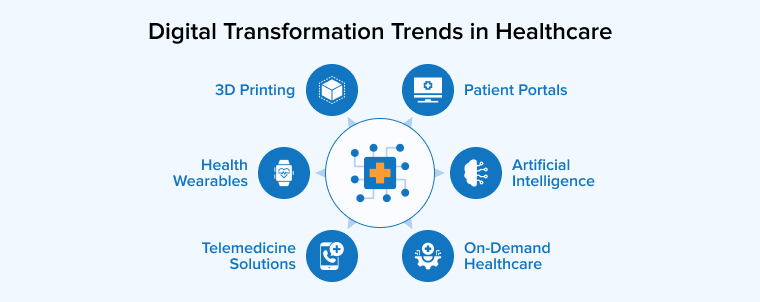
Digital transformation in the healthcare industry is largely driven by technological innovations and advancements. Implementing them has proven to be useful in improving patient outcomes and the organization’s operational efficiency. In this section, we discuss some trending digital investments that are transforming the healthcare sector.
4.1 Health Wearables
Initially, people used to seek the doctor’s help whenever something happened to them. But with the advent of digital tools and wearable technologies, people are becoming more proactive and conscious about their overall well-being.
Health wearables, such as smartwatches, are commonly used to track heart rate, sleep patterns, activity levels, and more. These devices offer continuous daily monitoring, which helps patients to know about disruptions in their vitals, allowing them to seek medical care or take appropriate measures before their health worsens.
Sweat meters, oximeters, fitness bands, and exercise trackers are some of the most popular health wearable devices. They collect and provide medical information to patients in real time and send alerts to the doctors in case of an anomaly.
4.2 On-Demand Healthcare
On-demand healthcare apps allow patients to avoid the inconveniences of visiting the clinics for routine checkups and doctor consultations. Patients can use these apps to schedule their appointments from the comfort of their homes, make payments directly through the app, receive summaries of their medical reports, and consult with their doctors through video conferencing.
On-demand healthcare apps also provide an option for home visits where medical professionals visit the patient’s house to draw blood for relevant tests. This solution enables patients to receive medical care anywhere, anytime. This technology is particularly beneficial for people residing in remote areas.
4.3 Artificial Intelligence
Healthcare providers can enhance patient care by integrating AI into their software solutions. AI can act as a virtual healthcare assistant, familiar with a patient’s medical information, assisting in diagnosing conditions and reminding patients about prescription refills, doctor visits, etc. AI is also helpful in keeping track of the patient’s symptoms and in remote monitoring.
Healthcare researchers can leverage AI to develop new medications, perform clinical trials, offer accurate analytical results, and help doctors with better decision-making.
4.4 Telemedicine Solutions
Telemedicine software solutions have been used for a long time, but they have become widely used and the most convenient option during the COVID-19 pandemic. It allows patients and doctors to communicate through audio and video calls. This helps provide contactless medical aid to patients living far distances or in remote areas. Attending a virtual appointment seems like a big help for patients suffering from chronic diseases or mobility issues.
4.5 3D Printing
3D printing, also known as additive manufacturing, is revolutionizing the healthcare industry. This technology enables the efficient creation of custom implants, prosthetics, and medical devices on-site from a digital file using advanced materials. It’s a quick and cost-effective way of obtaining the required prototypes and final products used for healthcare services.
3D-printed prosthetics are more comfortable as they are customized to individual patients, unlike traditional prosthetics with a generalized fit. 3D printing is also used to create models of body parts and organs, which have proven helpful for educational purposes. Furthermore, 3D-printed organs also help surgeons to plan and prepare for complex surgical procedures.
4.6 Patient Portals
The patient portal is one of the most useful platforms in healthcare digital transformation. It acts like a one-stop healthcare service center for patients, allowing them to access and review their medical history, request prescription refills, schedule appointments with their doctor or chat with them, check their test results, and more.
Doctors can also use this portal to access patients’ medical records and connect with patients in real-time to discuss their treatment plans. Healthcare facilities utilize patient portals to promote convenience and transparency.
Integrating this portal with virtual care platforms allows for telehealth visits or provides non-emergency medical care from a single place. Patient portals have been shown to improve adherence to therapy programs and provide better treatment.
Further Reading on: Patient Portal Development
5. Conclusion
The digital transformation came as a boon for health services. As the world is moving towards digitalization, medical professionals must keep pace with these changes. Through digital transformation, healthcare can enable them to offer enhanced patient care with better productivity. The digital transformation efforts have helped improve the efficiency of a wide range of clinical processes.


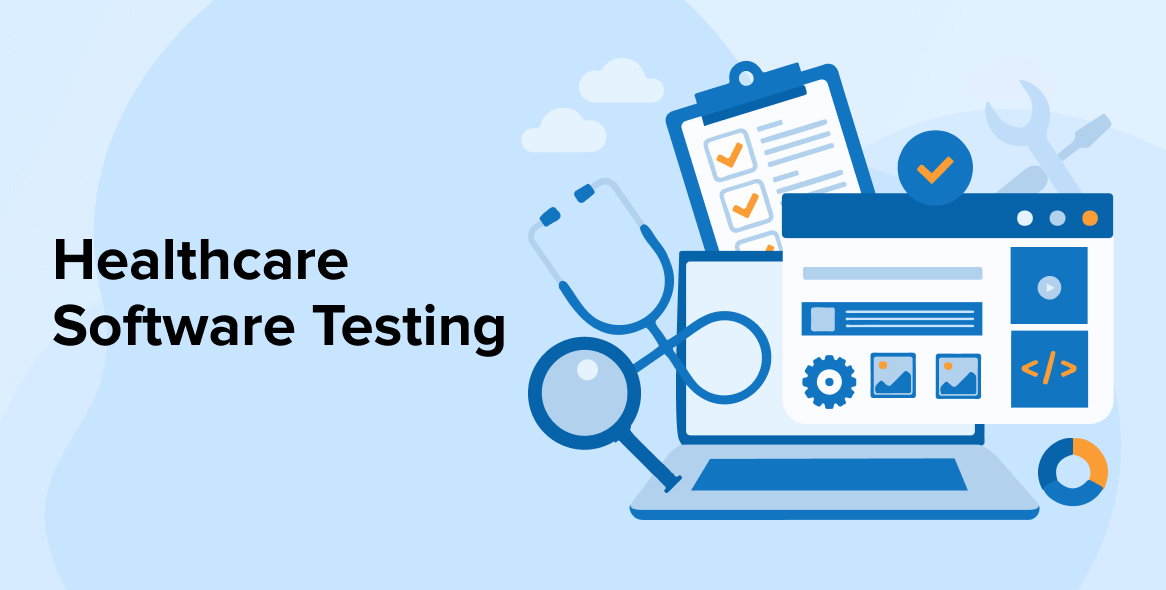

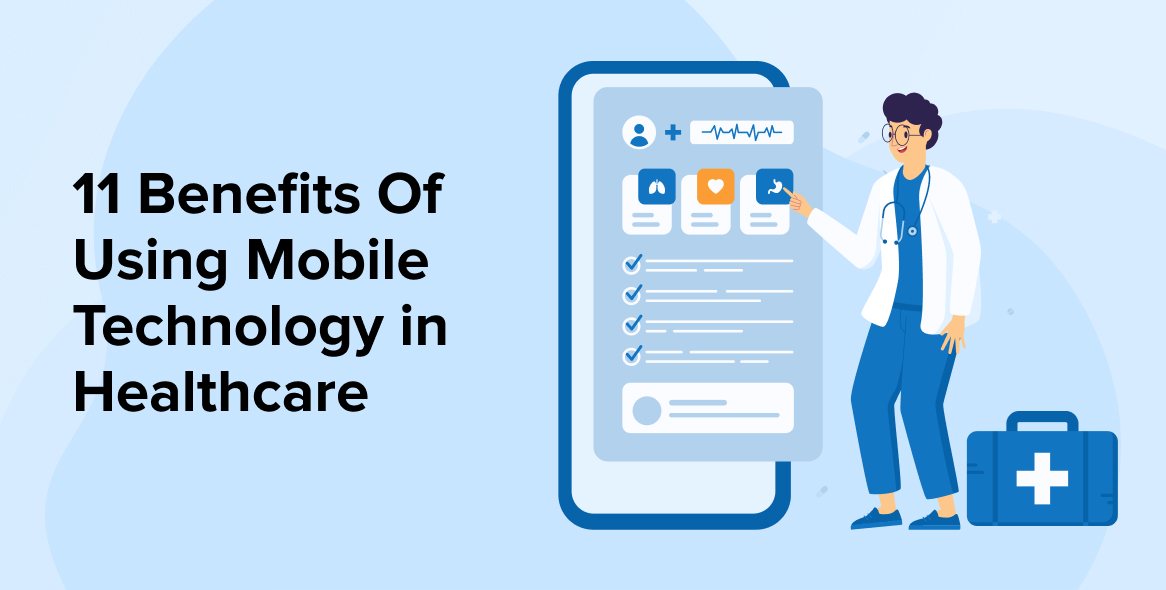

Comments
Leave a message...